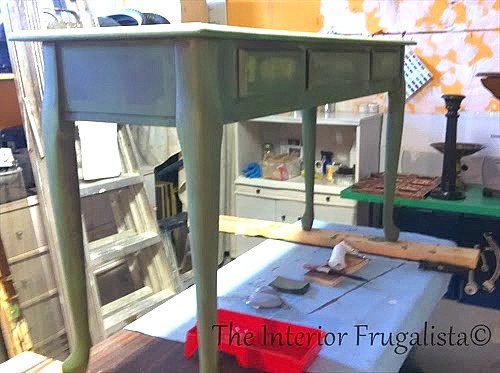How To Paint Furniture With Milk Paint
To distress or not to distress, that is the question? In this post, I'm sharing tips on how to paint furniture with milk paint and control the chippy goodness known for this non-toxic water-based paint that comes in powder form.
I love the unpredictability of milk paint. It's like opening presents on Christmas morning because you never know what you're going to get. Will the paint crackle and chip a little or a lot? But if the chippy look isn't your preference, there are ways you can control the finish and I'm going to show you how.
Milk paint has been around since the 1800s where it was made with a combination of milk, lime and natural pigments from plants and berries. Today's milk paint comes in a powder form with multiple color choices where you simply add water to a milk-like consistency.
To give you a visual of the process we're going to paint a 3-drawer cherry sofa table that has been in my home for over a decade. We're taking it out of the '90s and giving it an aged distressed patina.
So it looks like this...
I've included affiliate links in this post so you can find the products I used or recommend to complete this project. At no cost to you, I may receive a small commission if you make a purchase.
The table was painted with two coats of Miss Mustard Seed milk paint in Boxwood Green and this is what it looked like after one coat.
The top of the table and the drawer fronts are also painted with Miss Mustard Seed Milk Paint in the color Ironstone White.
Here is an example of the unpredictability of milk paint and instead of repainting the drawer fronts I embraced the chippy finish by aging the white paint with dark wax.
You can decrease the amount of crackle or chipping by adding a bonding agent to the paint. A bonding agent is a water-based acrylic emulsion that allows the paint to bond with metal, glass, varnished or lacquered finishes.
You control how much crackle and chipping you want by the amount of bonding agent added to the paint. A 2 part paint to 1 part bonding agent ratio is recommended.
Apply a small amount with a lint-free rag or inexpensive chip brush and let it soak into the paint for 2 hours between coats and wipe away excess after 12 hours.
It is recommended you wait at least 24 hours before applying the tough coat on fresh paint. You should apply two coats, waiting 2-4 hours between coats.
So what do you think, would you give milk paint a try? I hope these tips answered any questions you may have about painting furniture with milk paint. If not, please ask away in the comment section below or drop me an email by pressing the Contact Me button at the top of the blog. I'd be happy to answer them.
See my Painted Furniture page for more furniture makeover inspiration.
I love the unpredictability of milk paint. It's like opening presents on Christmas morning because you never know what you're going to get. Will the paint crackle and chip a little or a lot? But if the chippy look isn't your preference, there are ways you can control the finish and I'm going to show you how.
How To Paint Furniture With Milk Paint
Milk paint has been around since the 1800s where it was made with a combination of milk, lime and natural pigments from plants and berries. Today's milk paint comes in a powder form with multiple color choices where you simply add water to a milk-like consistency.
To give you a visual of the process we're going to paint a 3-drawer cherry sofa table that has been in my home for over a decade. We're taking it out of the '90s and giving it an aged distressed patina.
So it looks like this...
I've included affiliate links in this post so you can find the products I used or recommend to complete this project. At no cost to you, I may receive a small commission if you make a purchase.
The table was painted with two coats of Miss Mustard Seed milk paint in Boxwood Green and this is what it looked like after one coat.
The top of the table and the drawer fronts are also painted with Miss Mustard Seed Milk Paint in the color Ironstone White.
Here is an example of the unpredictability of milk paint and instead of repainting the drawer fronts I embraced the chippy finish by aging the white paint with dark wax.
Steps for painting furniture with milk paint:
Prepping cherry or mahogany before applying milk paint
Dark or redwoods like mahogany and cherry are guaranteed to cause paint bleed (when the natural tannins in the wood seep through the paint). To avoid this, seal the wood with a coat of shellac applied with an inexpensive chip brush.How to mix milk paint
As I mentioned earlier in this post, milk paint comes in a powder form.- Mix 1 part milk paint powder to 1 part warm water.
- Mix them together with either a fork, small kitchen whisk, or handheld milk frother.
- Stir out any lumps, adding a little more water if need be.
- If it is still quite lumpy you may have to strain the paint with either a nylon stocking, cheesecloth, or my preference - a small kitchen strainer with handle.
- Milk paint has a shelf life of two weeks to a month maximum. I prefer storing mine in recycled plastic soup or yogurt containers with a lid or glass mason jars.
The natural crackle of milk paint
The beauty of milk paint is that as the paint dries it will crack and expose the layer underneath. It can provide a beautiful distressed finish, especially when painting each layer a different color. But it also looks beautiful painted the same color with dark wax nestled into all the crackles. We'll talk more about finishes later in this post.Control the crackle and chipping of milk paint
You can increase the amount of crackling with a hair dryer or heat gun while it's drying.You can decrease the amount of crackle or chipping by adding a bonding agent to the paint. A bonding agent is a water-based acrylic emulsion that allows the paint to bond with metal, glass, varnished or lacquered finishes.
You control how much crackle and chipping you want by the amount of bonding agent added to the paint. A 2 part paint to 1 part bonding agent ratio is recommended.
Dry time between coats of milk paint
The recommended drying time between coats of milk paint is 2-4 hours. You will get full coverage with 2-3 coats of milk paint.Protective top coat finishes for milk paint
Let the milk paint dry for at least 24 hours before applying a top coat. There are several types of top coats that work beautifully with milk paint.Beeswax
The most common is beeswax applied in a thin layer over the milk paint with a lint-free rag or brush. Be sure to get the wax into the ridges, cracks, and details of the piece and buff to a beautiful matte finish.Color Beeswax
Once the clear beeswax has been applied, bring out all those lovely crackled or chippy details with colored wax. Apply it the same way you apply the clear beeswax but instead wipe off the excess. My preference is dark wax for an aged antique finish but white wax over blue or green is quite lovely too.Hemp Oil
Hemp Oil is an all natural solvent free oil that penetrates into porous milk paint and provides a beautiful matte finish. It also works beautifully to revive bare wood and provides a food-safe alternative for butcher block counters, cutting boards, wooden spoons, etc.Apply a small amount with a lint-free rag or inexpensive chip brush and let it soak into the paint for 2 hours between coats and wipe away excess after 12 hours.
Tough Coat
Tough coat is a non-yellowing clear finish that is perfect for things like tabletops and chairs that receive a lot of wear and tear. It can be applied with a brush, applicator sponge, or a paint sprayer for a factory finish.It is recommended you wait at least 24 hours before applying the tough coat on fresh paint. You should apply two coats, waiting 2-4 hours between coats.
So what do you think, would you give milk paint a try? I hope these tips answered any questions you may have about painting furniture with milk paint. If not, please ask away in the comment section below or drop me an email by pressing the Contact Me button at the top of the blog. I'd be happy to answer them.
See my Painted Furniture page for more furniture makeover inspiration.









Comments
Post a Comment
Don't be shy, I love reading your comments and reply to every single one! If you want to be notified when I reply back to you, click the "Notify Me" button below the comment box.